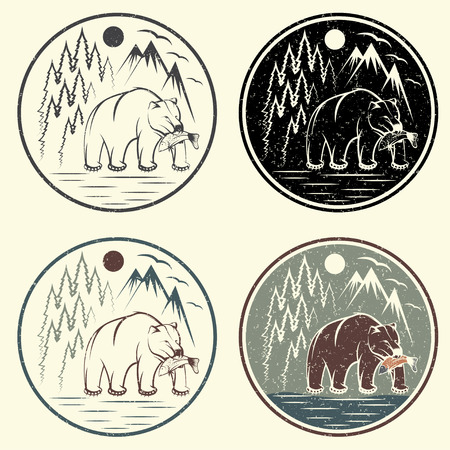1. Understanding Bear Behavior
When youre camping in the U.S. wilderness, one of the most important safety steps is understanding the behavior of bears. Knowing how different species act in their natural environment helps you avoid unwanted encounters and keep your campsite safe.
Common Bear Species in the U.S.
There are three main types of bears found across the United States. Each species behaves differently and lives in different regions. Heres a quick overview:
| Bear Species | Common Locations | Typical Behavior |
|---|---|---|
| Black Bear | Most of the U.S., especially forests and mountains | Cautious, usually avoids people but may enter campsites for food |
| Grizzly Bear (Brown Bear) | Northern Rockies, parts of Alaska, and Yellowstone area | Aggressive if surprised or protecting cubs; very strong and territorial |
| Polar Bear | Northern Alaska (Arctic regions only) | Mainly coastal, rarely encountered by campers unless in far north |
Bears Are Attracted to Food Smells
Bears have an incredibly strong sense of smell—up to seven times better than a bloodhounds. Theyre naturally curious and will investigate any scent they find interesting. This includes not just food but also items like toothpaste, deodorant, or even empty food wrappers.
Why Bears Approach Campsites
- Scented Items: Food, garbage, toiletries, and cooking tools can all attract bears.
- Lack of Food Storage: Improperly stored food is one of the top reasons bears visit campsites.
- Noisy or Unclean Campsites: Bears may associate human activity with easy meals if theyve been fed before.
The Importance of Knowing Their Habits
Bears are not naturally aggressive toward humans, but they can become dangerous when surprised, threatened, or used to finding food near people. By understanding their habits—like being more active at dawn and dusk—you can plan your camping activities more safely. Avoid hiking alone during those hours, and always stay alert to signs of bear activity like tracks or scat.
Your First Step to Safety: Awareness
The more you know about bear behavior, the better prepared youll be to camp safely. Awareness helps prevent close encounters and ensures both you and the bears stay safe in the wild.
2. Proper Food Storage Techniques
When youre camping in bear country, how you store your food can make all the difference between a peaceful night and an unexpected visit from a curious bear. Bears have an incredible sense of smell and are naturally drawn to anything that smells like food — even items you might not expect, like toothpaste or sunscreen.
Use Bear-Proof Containers
The safest way to store food and scented items is in a certified bear-proof container. These hard-sided containers are designed to keep bears out, even if they try to bite, claw, or roll them away. Many national parks and wilderness areas require these containers, so check local regulations before you go.
What to Store in Bear-Proof Containers
| Item | Why It Attracts Bears |
|---|---|
| Food (cooked or uncooked) | Strong scents and easy calories for bears |
| Snacks and energy bars | Sweet smells attract wildlife |
| Toiletries (toothpaste, deodorant, lotion) | Bears confuse these with food due to their scent |
| Garbage and food wrappers | Residual odors can still lure bears |
Hanging Your Food (When Containers Arent Available)
If youre camping somewhere that doesnt provide bear boxes and you dont have a bear canister, hanging your food properly is another option. Use the “10-10-4 rule”: hang your food bag 10 feet off the ground, 10 feet away from the tree trunk, and at least 4 feet below the branch its hanging from. This makes it harder for bears to reach it from the ground or climb out on a branch to grab it.
Tip:
Always hang or store your scented items at least 100 feet away from your tent. Never bring food into your sleeping area — not even snacks!

3. Setting Up a Bear-Safe Campsite
When youre camping in bear country, how and where you set up your campsite plays a big role in keeping you safe. Bears have an incredible sense of smell and are naturally curious, so taking the right precautions can make all the difference. Here’s how to set up a bear-safe campsite during your outdoor adventure.
Choose the Right Campsite Location
Picking the right spot is your first line of defense against unwanted wildlife encounters. Avoid areas with obvious signs of bear activity such as tracks, scat, or claw marks on trees. Also, steer clear of berry patches, animal carcasses, or water sources where bears might come to drink.
Look for These Features When Choosing a Campsite:
| Do | Dont |
|---|---|
| Camp at least 200 feet from water sources | Set up near rivers or lakes |
| Choose open areas with good visibility | Camp in dense brush or near animal trails |
| Check for bear activity signs before setting up | Ignore tracks or droppings nearby |
Maintain a Clean Campsite
Bears are mostly attracted by smells, especially food odors. Keeping your site clean helps reduce the chance of drawing them in. That means no food scraps, trash, or scented items like toothpaste left out in the open.
Tips for Keeping Your Site Clean:
- Store all food and scented items in bear-proof containers or hang them at least 10 feet off the ground and 4 feet away from tree trunks.
- Never leave trash outside—pack it out or store it securely.
- Avoid using scented lotions, deodorants, or perfumes while camping.
- Clean dishes immediately after use and dump wastewater far from camp.
Create Separate Zones for Cooking and Sleeping
A common mistake is cooking too close to where you sleep. Instead, create a triangle layout with three distinct zones: sleeping area, cooking area, and food storage area—each at least 100 feet apart.
Campsite Triangle Layout:
| Zone | Description |
|---|---|
| Sleeping Area | Your tent should be set up in a clean area free from food smells and trash. |
| Cooking Area | This is where you prepare and eat meals. Keep it far from where you sleep. |
| Food Storage Area | Use a bear canister or hang food away from both other zones to reduce risk. |
Pro Tip:
If youre car camping in national parks or forests that provide bear boxes, always use them. Theyre one of the most effective ways to keep bears away from your supplies.
By being smart about where you camp and how you manage your space, youll lower your chances of running into a bear—and enjoy a safer, more peaceful night under the stars.
4. How to React During a Bear Encounter
Even with the best precautions, you might still come face-to-face with a bear while camping in the U.S. wilderness. Knowing how to react can make all the difference. Your response should depend on the type of bear—black bear or grizzly (also called brown bear)—and the situation youre in.
Stay Calm and Assess the Situation
The most important thing to do is stay calm. Do not run—this can trigger a chase response in bears. Take a deep breath, avoid sudden movements, and try to identify the type of bear.
Know the Difference: Black Bear vs. Grizzly Bear
Heres a quick comparison to help you identify which bear youre dealing with:
| Feature | Black Bear | Grizzly Bear |
|---|---|---|
| Size | Smaller (100–400 lbs) | Larger (300–800+ lbs) |
| Shoulder Hump | No hump | Prominent shoulder hump |
| Face Profile | Straight or slightly curved | Dished (concave) profile |
| Claws | Shorter, curved claws | Longer, straighter claws |
If the Bear Hasnt Noticed You Yet
If the bear is unaware of your presence, slowly back away while keeping an eye on it. Avoid direct eye contact, which may be seen as a challenge. Speak in a calm but firm voice so the bear knows youre human and not prey.
If the Bear Notices You but Isnt Acting Aggressively
Stand your ground. Wave your arms slowly and talk loudly but calmly. Most bears dont want confrontation and may leave once they recognize you as a human.
If the Bear Approaches You
This is when you need to carefully read its behavior:
- Curious or Defensive Behavior: The bear may huff, pop its jaws, or swat at the ground. This means its feeling threatened. Back away slowly—do not turn your back or run.
- Persistent Approach: If it keeps coming toward you despite your efforts, stand tall and prepare to use bear spray.
- Charging: Bears sometimes bluff charge. Stand your ground unless it makes contact.
If Contact Seems Imminent: Use Bear Spray
Bearing spray is highly effective when used correctly. Remove the safety clip and aim slightly downward toward the approaching bear. Spray when its within 30 feet, aiming for its face in short bursts. The mist will create a barrier that irritates the bear’s eyes and nose, often turning it away.
Bear Spray Tips:
- Keep it within reach—on your belt or pack strap—not inside your bag.
- Practice removing the safety clip quickly.
- Do not use it like bug spray—it’s only for emergencies.
If a Bear Attacks: Know What Kind of Attack It Is
| Type of Attack | Your Best Response |
|---|---|
| Defensive Attack (usually grizzlies) | Play dead. Lie flat on your stomach with hands behind neck and legs spread to make rolling difficult. Stay still until youre sure the bear has left. |
| Predatory Attack (more likely with black bears) | Fight back with everything youve got—sticks, rocks, fists—aiming for the face and muzzle. |
Remember: each encounter is different, but staying calm and making informed decisions greatly increases your chances of staying safe during a bear encounter in the wild.
5. Essential Gear for Bear Safety
When youre camping in bear country, having the right gear can make all the difference. Being prepared helps prevent unwanted bear encounters and keeps you, your group, and the bears safe. Below is a list of essential items every camper should pack when exploring the U.S. wilderness.
Bear Safety Gear Checklist
| Item | Description | How to Use Effectively |
|---|---|---|
| Bear Spray | A powerful pepper spray designed specifically to deter aggressive bears. | Carry it on your belt or in an easy-to-reach pocket. Practice using it beforehand so you know how it works. Spray when a bear approaches within 30 feet. |
| Bear Canister | A hard-sided container that stores food and scented items safely away from bears. | Store all food, toiletries, and trash inside. Place the canister at least 100 feet from your tent and downwind. |
| Bear Bells | Small bells attached to gear or clothing that make noise while you hike. | Clip them to your backpack or hiking boots to alert nearby bears of your presence, helping avoid surprise encounters. |
| Odor-Proof Bags | Bags designed to contain food smells that attract bears. | Use these inside your bear canister for extra protection. Seal them tightly after each use. |
| Headlamp or Flashlight | A reliable light source for nighttime visibility around camp. | Use when walking around camp after dark to spot wildlife and avoid surprising a bear at night. |
Bonus Tips for Gear Usage
- Practice using bear spray: Many outdoor stores offer inert practice cans so you can get comfortable with the technique before heading out.
- Pack smart: Keep bear-related gear easily accessible—not buried deep in your backpack.
- Check regulations: Some parks require approved bear canisters and may ban other food storage methods like hanging bags.
The right gear doesn’t just protect you—it also helps preserve natural wildlife behavior. When used correctly, these tools reduce human-bear conflicts and keep wild spaces safer for everyone.


